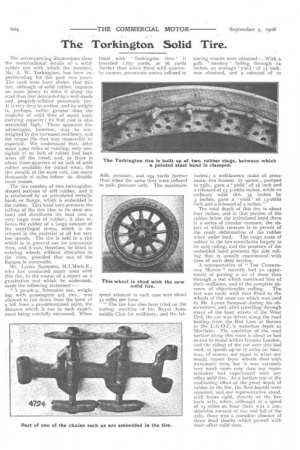The Torkington Solid Tire.
Page 6

If you've noticed an error in this article please click here to report it so we can fix it.
The accompanying illustrations show the constructional details of a solidrubber tire with which the inventor, Mr. A. W. Torkington, has been experimenting for the past two years. The road tests have shown that this Lire, although of solid rubber, requires no more power to drive it along the road than that demanded by a well-made and properly-inflated pneumatic tire. It is very deep. in section, and its weight is, perhaps, rather greater than the majority of solid tires of equal loadcarrying capacity ; its first cost is also somewhat high. These apparent disadvantages, however, may be outweighed by the increased resiliency, and the longer life that may reasonably be expected. We understand that, after some 3,000 miles of running, only oneeighth of an inch of rubber had been worn off the tread, and, as there is about three-quarters of an inch of solid rubber available for actual wear, the tire should, at the same rate, last many thousands of miles before its disablement ensues.
The tire consists of two rectangularshaped sections of soft rubber, and it is reinforced by an articulated metallic band, or flange, which is embedded in the rubber. This band both prevents the rolling of the tire (due to its deep section) and distributes the load over a very large area of rubber ; it also relieves the rubber of a large amount of the centrifugal stress, which is developed in the material at all but very low speeds. The tire is held in a rim which is in general use for pneumatic tires, and it can, therefore, be fitted to existing wheels without alteration to the rims, provided that one of the Ranges is removable.
Mr. Lyons Sampson, M.I.Mech.E., who has conducted many tests with this tire, in the course of a report on a gravitation test which he undertook, made the following statement :— " A 3o-4oh.p. limousine car, weighing with passengers 42-i cwt., was allowed to run down from the brow of a hill from a pre-determined point, the distance which it ran in each experiment being carefully measured. When fitted with ' Torkington tires ' it travelled 1,677 yards, or 76 yards further than when fitted with 920mm. by 12onme pneumatic covers inflated to Solb. pressure, and 254 yards further than when the same tires were inflated to solb. pressure only. The maximum speed attained in each case was about 43 miles per hour.
" The tire has also been tried on the testing machine of the Royal Automobile Club for resiliency, and the fol lowing results were obtained :—With a
4011). monkey ' falling through 24 inches, an average yield ' of t*inch, was obtained, and a rebound of to inches ; a well-known make of pneumatic tire 81omm. by gomm., pumped to 751b., gave a 'yield ' of i inch and a rebound of 13 3-16ths inches, while an ordinary solid tire, 34 inches by 3 inches, gave a yield ' of 13-16ths inch and a rebound of 2 inches."
The total depth of this tire is about four inches, and in that portion of the rubber below the articulated band there is a series of circular recesses, the object of which recesses is to permit of the ready deformation of the rubber when under load. The large mass of rubber in the tire contributes largely to its easy riding, and the presence of the embedded band prevents the side rolling that is usually experienced with tires of such deep section.
A representative of " THE Comm-KRmu, MOTOR recently had an opportunity of putting a set of these tires through a test which convinced him of their resilience, and of the complete ab sence of objectionable rolling. The test was made with tires fitted to the wheels of the same car which was used by Mr. Lyons Sampson during his observations, and, after travelling through many of the busy streets of the West End, the car was driven along the road leading from the Red Lion at Barnes to the L.G.O.C.'s motorbus depot at Mortlake. The condition of the road surface along this route is about as bad as can be found within Greater London, and the riding of the car over this bad road, at speeds up to 17 miles an hour, was, of course, not equal to what one would expect from wheels shod with pneumatic tires, but it was certainly very much more easy than our representative had experienced with any other solid tire. As a further test of the cushioning effect of the great depth of rubber in the tire, the floor-boards were removed, and our representative stood, with knees rigid, directly on the live back axle, when, although at a speed of 15 miles an hour there was a considerable amount of rise and fall of the axle, there was a complete absence of those dead shocks which prevail with most other solid tires.


















